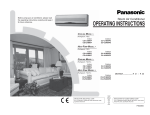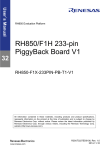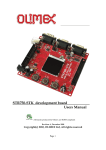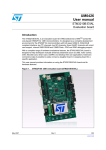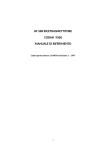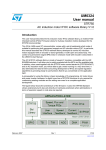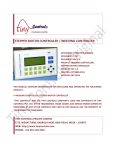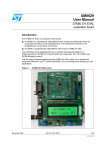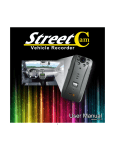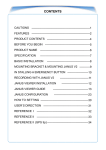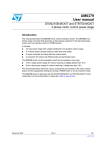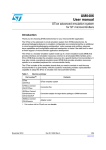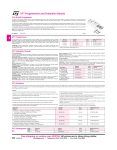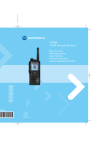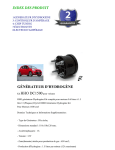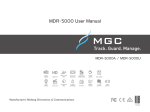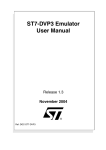Download STR750-EVAL evaluation board
Transcript
UM0268 User Manual STR750-EVAL Evaluation board Introduction The STR750 evaluation board (STR750-EVAL) is a complete, development platform for STMicroelectronic’s ARM® core-based STR75xF microcontrollers. Based on a cost effective, flexible and open design, it allows easy demonstration of STR75xF capabilities and enables rapid evaluation of the microcontroller’s peripherals and other features. It includes the high performance STR750F microcontroller, which is based on the ARM7TDMI-S core and includes USB 2.0 compliant port with full speed data transmission, CAN 2.0A/B compliant interface, 3 UART channels, internal Flash and internal SRAM memory. The STR750-EVAL features a complete range of connectors and hardware features for developing applications based on STR75xF peripherals including motor control, USB and RS232 connectors, microphone, speaker, joystick, and LCD display. The STR750-EVAL uses a JTAG standard interface to connect to your host PC via any of a range of in-circuit emulators (ICE) for ARM core-based microcontrollers. STR750-EVAL evaluation board Features ■ Three 5V power supply options: Power jack, USB ■ Inductor Motor Control connector with 6 PWM connection or daughter board output and Emergency Stop ■ RTC ■ Audio play and record ■ 3 RS232 connectors, one with hardware flow control ■ Debug and programming support via 20-pin JTAG connector ■ Dot-matrix LCD module ■ Joystick with 4-direction control and selector ■ USB 2.0 compliant with full speed (12Mb/s) data ■ Extension connectors for daughter board or transmission wrapping board ■ CAN 2.0A/B connection November 2006 Rev 2 1/40 www.st.com STR750-EVAL About the user manuals... This user manual provides information about using your STR750-EVAL and its hardware features. For additional information about supporting software and tools, please refer to: STR75xF Datasheet– Complete information about microcontroller features and peripherals STR75xF Demonstration Software User Manual– Guide to using the demo software provided with your STR750-EVAL STR75xF Hardware Development Getting Started– Guide to developing your application hardware 2/40 STR750-EVAL Contents 1 Getting Started . . . . . . . . . . . . . . . . . . . . . . . . . . . . . . . . . . . . . . . . . . . . . . . . 5 2 Hardware layout and configuration . . . . . . . . . . . . . . . . . . . . . . . . . . . . . . . 6 3 4 2.1 Power supply . . . . . . . . . . . . . . . . . . . . . . . . . . . . . . . . . . . . . . . . . . . . . . . . . 8 2.2 Boot option . . . . . . . . . . . . . . . . . . . . . . . . . . . . . . . . . . . . . . . . . . . . . . . . . . 10 2.3 Clock source . . . . . . . . . . . . . . . . . . . . . . . . . . . . . . . . . . . . . . . . . . . . . . . . . .11 2.4 Reset source . . . . . . . . . . . . . . . . . . . . . . . . . . . . . . . . . . . . . . . . . . . . . . . . . .11 2.5 Audio features . . . . . . . . . . . . . . . . . . . . . . . . . . . . . . . . . . . . . . . . . . . . . . . . .11 2.6 Serial Flash . . . . . . . . . . . . . . . . . . . . . . . . . . . . . . . . . . . . . . . . . . . . . . . . . . 12 2.7 CAN . . . . . . . . . . . . . . . . . . . . . . . . . . . . . . . . . . . . . . . . . . . . . . . . . . . . . . . 12 2.8 RS232 . . . . . . . . . . . . . . . . . . . . . . . . . . . . . . . . . . . . . . . . . . . . . . . . . . . . . . 12 2.9 Motor Control . . . . . . . . . . . . . . . . . . . . . . . . . . . . . . . . . . . . . . . . . . . . . . . . 13 2.10 RTC . . . . . . . . . . . . . . . . . . . . . . . . . . . . . . . . . . . . . . . . . . . . . . . . . . . . . . . . 13 2.11 USB . . . . . . . . . . . . . . . . . . . . . . . . . . . . . . . . . . . . . . . . . . . . . . . . . . . . . . . . 13 2.12 Joystick . . . . . . . . . . . . . . . . . . . . . . . . . . . . . . . . . . . . . . . . . . . . . . . . . . . . . 14 2.13 Development and debugging tool support . . . . . . . . . . . . . . . . . . . . . . . . . . 14 2.14 Display and input devices . . . . . . . . . . . . . . . . . . . . . . . . . . . . . . . . . . . . . . . 14 Connectors . . . . . . . . . . . . . . . . . . . . . . . . . . . . . . . . . . . . . . . . . . . . . . . . . . 16 3.1 Motor control connector CN1 . . . . . . . . . . . . . . . . . . . . . . . . . . . . . . . . . . . . 17 3.2 USB type B connector CN2 . . . . . . . . . . . . . . . . . . . . . . . . . . . . . . . . . . . . . 18 3.3 Power supply connector CN3 . . . . . . . . . . . . . . . . . . . . . . . . . . . . . . . . . . . . 18 3.4 RS232 connectors CN4, CN8 and CN10 . . . . . . . . . . . . . . . . . . . . . . . . . . . 19 3.5 CAN type D, 9-pin connector CN5 . . . . . . . . . . . . . . . . . . . . . . . . . . . . . . . . 20 3.6 JTAG debug connector CN9 . . . . . . . . . . . . . . . . . . . . . . . . . . . . . . . . . . . . . 20 3.7 External speaker jack CN11 . . . . . . . . . . . . . . . . . . . . . . . . . . . . . . . . . . . . . 21 3.8 Daughter board extension connector CN6 and CN7 . . . . . . . . . . . . . . . . . . 21 Schematics . . . . . . . . . . . . . . . . . . . . . . . . . . . . . . . . . . . . . . . . . . . . . . . . . . 25 Appendix A Implemented pin functions of STR750F . . . . . . . . . . . . . . . . . . . . . 33 3/40 STR750-EVAL Appendix B Product Support. . . . . . . . . . . . . . . . . . . . . . . . . . . . . . . . . . . . . . . . . 37 Appendix C Revision history . . . . . . . . . . . . . . . . . . . . . . . . . . . . . . . . . . . . . . . . . 39 4/40 STR750-EVAL 1 1 Getting Started Getting Started Your STR750-EVAL is designed with a full range of hardware features that will help you rapidly evaluate microcontroller peripherals and develop your own applications. Descriptions of hardware features and configurations are provided in Chapter 2. Demonstration software is preloaded in the board’s flash memory for easy demonstration of device peripherals in stand-alone mode. For more information refer to the demonstration software getting started. Your STR750-EVAL is also designed for use as an application development platform and reference design, and supports connection to a full range of in-circuit debugging tools and integrated development environments. Figure 1.Connecting development tools To start using your STR750-EVAL evaluation board for application development, you will have to set up your development tools and connect to the STR75xF. Host PC running your debugging software / integrated development environment 1. Connect to your STR750-EVAL via the 20-pin JTAG connector. 2. Power up the evaluation board. The board can be powered by 5V from either the jack for external power supply, USB connector, or a daughter board. For additional configuration information, see Section 2.1. 3. Connect to the device from the debugging software on your host PC. In-circuit emulator connects via 20-pin JTAG standard connector In-circuit emulator The software files and installation instructions that you will need to update your debugging software are available for free download at www.st.com/mcu. The download includes instructions for creating a new connection to your microcontroller. 5/40 2 Hardware layout and configuration 2 STR750-EVAL Hardware layout and configuration The STR750-EVAL is designed around the STR750Fx in an LQFP100 (14x14) package.The hardware block diagram of the STR750-EVAL (See Figure 1) illustrates the layout of the board relative to the STR750F peripherals (LCD, SPI, UART, USB, Audio, CAN, RTC and Motor Control) and Figure 3 will help you locate these features on the actual evaluation board. Figure 2. 6/40 Hardware Block Diagram STR750-EVAL 2 Hardware layout and configuration Figure 3. STR750-EVAL evaluation board layout Motor control connector, CN1 Daughter board extension connectors, CN6, CN7 Power supply jack, CN3 USB type B connector, CN2 STR750Fx, U8 RS232 connector with hardware flow control, CN4 CAN D-type 9-pin connector, CN5 RS232 Connectors, CN8, CN10 JTAG debug connector, CN9 External 8Ω speaker jack, CN11 Audio volume control, RV1 Speaker, U11 Graphic LCD Module, U16 Preamplifier gain adjustment, RV3 General Purpose Key, PB3 Potentiometer, RV2 Microphone, U17 RESET, PB1 WAKEUP, PB2 Joystick, U18 7/40 2 Hardware layout and configuration STR750-EVAL Hardware configuration The following sections provide jumper settings for configuring your STR750-EVAL evaluation board and peripherals, including: ● ● ● ● ● ● ● Power supply Clock source Reset source Audio features Serial Flash CAN ● ● ● ● ● RS232 Motor Control RTC USB Development and debugging tool support Display and input devices Two types of jumpers are used on the STR750-EVAL evaluation board: ● 3-pin jumpers with two possible positions, for which the possible settings are presented in schematics in the following sections ● 2-pin jumpers with two possible settings: Fitted– the circuit is closed, and Not fitted– the circuit is open (see Figure 4.) Figure 4. Settings for two-pin jumpers Not fitted 2.1 Fitted Power supply The STR750-EVAL evaluation board is designed to be powered by a 5V DC power supply and is protected from incorrect power supply by a polymer enhanced Zener diode (polyzen, U19) which shuts out the power source if overvoltage occurs. If overvoltage occurs, the power supply must be disconnected from the board and then reconnected in order to reset the polyzen. It is possible to configure the evaluation board to use any of the following three sources for the power supply: ● 5V DC power adapter connected to the power supply jack (CN3, or PSU for Power Supply Unit on the silk screen). ● 5V DC power with 500mA limitation via the USB type-B connector (CN2, or USB on the silk screen). ● 5V DC power from the daughter board extension connectors (CN6 and CN7, DTB for Daughter Board on the silk-screen). You can power the ARM7TDMI-S core, SRAM, and Flash of the STR750Fx using one of two power supply sources: 8/40 ● Internal power supply generated by internal Main Voltage Regulator. ● External power supply generated by external 1.8V voltage regulator U4 on the board STR750-EVAL 2 Hardware layout and configuration The power supply is configured by setting the related jumpers, JP1, JP3, JP4, JP5 and JP6 as described in Table 1. Table 1. Power jumpers Jumper JP1 Description Selects one of the three possible 5V DC power supply sources: USB USB PSU DTB USB PSU DTB USB JP3 DTB For power supply from USB (CN2), JP1 is set as shown to the right: If a daughter board is connected on CN5 and CN6, it must have its own power supply connected. PSU For power supply from the daughter board connectors (CN6 and CN7), JP1 is set as shown to the right: DTB For Power supply jack (CN3) to both STR750-EVAL evaluation board and a daughter board connected to CN6 and CN7, JP1 is set as shown to the right: The daughter board must not have its own power supply connected. PSU For Power supply jack (CN3) to the STR750-EVAL only, JP1 is set as shown to the right: The daughter board must have its own power supply connected. (Default setting) Enables consumption measurement of STR75xF 3.3V VPLL, VADC and CPU_3V3. Default setting: Fitted Note: The Potentiometer (RV2) is also connected to VADC. As a result, measurements of the consumption of the STR75xF include the consumption of the potentiometer (~330 µA). To determine the actual consumption of the STR75xF either subtract 330 µA from the consumption measurement, or remove (un-solder) the potentiometer from the board. JP4, JP5, JP6 1.8V power can be provided externally or internally depending on the configuration of the jumpers JP4, JP5 and JP6: ● For 1.8V power supply from the external regulator U4 to the STR750Fx, jumpers JP4, JP5 and JP6 should all be fitted. In this mode, JP5 and JP6 can be used for consumption measure of V18BKP and V18 respectively. ● For 1.8V power supply from the internal Main Regulator, jumpers JP4, JP5 and JP6 should not be fitted. Caution: Do not use configuration patterns of JP4, JP5 and JP6 other than the two described above. Default setting: Not fitted The LD1 LED is lit when the STR750-EVAL evaluation board is powered correctly. 9/40 2 Hardware layout and configuration 2.2 STR750-EVAL Boot option The STR750Fx-EVAL evaluation board is able to boot from: ● Embedded User Flash ● Embedded SRAM for debugging ● System memory with boot loader for ISP ● External 64Mbit SPI Interface Flash U2 The boot option is configured by setting switches SW1 and SW2 as shown in Table 2. These micro switches have two possible positions: Switch positions 1< >0 Figure 5. Switch in position “1” Boot mode selection >0 To boot from Embedded User Flash, set switches SW1 and SW2 as shown to the right. (Default setting) 1< SW1, SW2 Description SW1 Boot 0 Jumper SW2 Boot 1 Table 2. Switch in position “0” SW1 Boot 0 SW2 Boot 1 SW1 Boot 0 To boot from External SPI Interface Flash, set switches SW1 and SW2 as shown to the right. SW1 Boot 0 1< >0 1< >0 1< >0 SW2 Boot 1 To boot from System Memory, set switches SW1 and SW2 as shown to the right. SW2 Boot 1 To boot from Embedded SRAM, set switches SW1 and SW2 as shown to the right. 10/40 STR750-EVAL 2.3 2 Hardware layout and configuration Clock source Three clock sources are available on the STR750-EVAL evaluation board for the microcontroller, USB and RTC. ● X1– 32KHz crystal for embedded RTC ● X2– 4MHz crystal for STR750Fx microcontroller ● U7– 48MHz oscillator for USB USB is also able to run using the 48MHz clock from the STR750Fx. The option of using a 48MHz oscillator (U7) is only a backup option for the USB peripheral. The oscillator is not present on the board, but can be added if necessary. 2.4 Reset source The reset signal of STR750-EVAL evaluation board is low active. The reset sources include: ● Power On Reset from STM1818 (U14) ● Reset button (PB1) ● Debugging tools via the connector CN9 ● Daughter board via the connector CN7 Table 3. Reset jumpers Jumper JP13 2.5 Description Enables reset of the STR750Fx embedded JTAG TAP controller each time a system reset occurs. JP13 connects the TRST signal from the JTAG connection with the system reset signal RESET#. Default setting: Fitted Audio features STR750-EVAL evaluation board supports both audio recording and playback. This can be disabled or enabled by setting of jumpers JP16 and JP17. Potentiometers for audio control include: ● Volume control using the potentiometer RV1. ● Gain control on the micro preamplifier using the potentiometer RV3. The connector CN11 allows the connection of an external 8Ω speaker. When an external speaker is connected, the speaker (U11) on the evaluation board is disconnected. Table 4. Jumper JP16 Audio jumpers Description Audio power amplifier TS4871 is forced into standby mode when JP16 (SPEAKER on the silk-screen) is not fitted. Default setting: Fitted 11/40 2 Hardware layout and configuration Table 4. Audio jumpers Jumper 2.6 STR750-EVAL Description JP17 Microphone pre-amplifier MAX4061 is forced into shutdown mode when JP17 (MIC on the silk-screen) is fitted. Default setting: Not fitted JP15 Audio play circuit is connected to P1.02 of STR750Fx when JP15 (Audio on the silkscreen) is fitted. Default setting: Fitted Serial Flash 64Mbit SPI interface flash is available on the STR750-EVAL evaluation board. The evaluation board can be booted from SPI interface flash. For jumper configurations related to boot modes, refer to Section 2.2. 2.7 CAN STR750-EVAL evaluation board supports CAN2.0A/B compliant bus communication based on the 3.3V CAN transceiver. Both high-speed mode and slope-control mode are available and can be selected by setting JP8. Table 5. Jumper Description 2.8 SLOPE JP9 SLOPE CAN transceiver functions in high-speed mode when JP8 is set as shown on the right: (Default setting) HIGH CAN transceiver functions in slope-control mode when JP8 (HIGH or SLOPE on silk-screen) is set as shown to the right: HIGH JP8 CAN jumpers CAN terminal resistor is enabled when JP9 (CAN_terminal on the silk-screen) is fitted. Default setting: Not fitted RS232 A total of three channels for RS232 communication are available on the STR750-EVAL evaluation board. UART0 uses the RS232 transceiver U9 and the male D-type 9-pin connector CN4. This channel implements UART hardware flow control. Two channels UART1 and UART2, use the RS232 transceiver U12 and two male D-type 9-pin connectors CN8 and CN10. 12/40 STR750-EVAL 2.9 2 Hardware layout and configuration Motor Control STR750-EVAL evaluation board supports induction motor control via a 34-pin connector CN1, which provides all required control and feedback signals to and from a motor power-drive board. Available signals on this connector include emergency stop, motor speed, 3-phase motor current, bus voltage, Heatsink temperature from the motor drive board and 6 channels of PWM control signals going to the motor drive circuit. Motor current sampling is enabled by setting jumper JP7. Table 6. Motor control jumpers Jumper JP7 2.10 Description Motor current sampling operation is enabled when JP7 is fitted (P1.08 connected to P0.29). The I/O pins P1.08 and P0.29 are disconnected and can be used by a daughter board when JP7 is not fitted. Default setting: Fitted RTC A 32KHz crystal X1 is available for the embedded RTC inside the STR750Fx. 2.11 USB STR750-EVAL evaluation board supports USB 2.0A/B compliant full speed communication via a USB type-B connector (CN2). The evaluation board and daughter board can be powered from this USB connection at 5V DC with a 500mA current limitation. Two clock sources are available for USB: ● PLL generated clock from the STR750Fx ● External oscillator U7 USB Connect/Disconnect Simulation allows the application software to simulate the connection or disconnection of a USB apparatus to connector CN2 of the STR750-EVAL. This feature is implemented by connecting P0.09 of the STR75xF to the transistor that controls the connection of the USB 1.5K pull-up resistor (R6) on the USB_D+ line. The USB Connect/Disconnect Simulation feature is enabled or disabled by setting JP2 as shown in Table 7. Table 7. Jumper JP2 USB Connect/Disconnect Simulation Description 2 3 1 2 3 When JP2 is set as shown to the right, USB Connect/Disconnect Simulation is enabled. P0.09 of the STR75xF is connected to the transistor that controls the connection/disconnection of the USB 1.5K pull-up resistor (R6) on the USB_D+ line. When USB Connect/Disconnect Simulation is enabled, by default the USB 1.5K pull-up resistor (R6) is in a “disconnect” state (i.e. as if no USB apparatus were connected to CN2). (Default setting) 1 When JP2 is set as shown to the right, USB Connect/Disconnect Simulation is disabled. In this case, the USB 1.5K pull-up resistor is connected to the USB_D+ line and P0.09 is not use for USB. 13/40 2 Hardware layout and configuration 2.12 STR750-EVAL Joystick STR750-EVAL evaluation board includes a 4-position joystick (U18). When used, the joystick “up position” is connected to P0.08 of the STR750Fx. Otherwise this pin can be used to drive an I2C component via the daughter board connectors. Use of pin P0.08 for either of these two functions is controlled using JP18. Table 8. Joystick jumper Jumper Description JP18 JP18 P0.08 is used in its alternate function I2C_SCL and connected to the daughter board connector (CN7, pin 38) when JP18 is set as shown on the right: 1 2.13 P0.08 is connected to the joystick when JP18 is set as shown to the right: (Default setting) 1 JP18 Development and debugging tool support The STR750-EVAL evaluation board supports connection to In-Circuit Emulators (ICE) via a 20-pin standard JTAG interface (CN9). 2.14 Display and input devices 122x32 pixel graphic LCD and 4 general purpose LED's (LD2, 3, 4, 5) are available as display devices. A 4-direction joystick with selection key, a general purpose button (PB3) and a wake up button (PB2) are available as input devices. STR750-EVAL also supports a second optional 2x16 character LCD that can be mounted on the connector U15. Table 9. LCD modules Graphic LCD U16 (default) Pin on U16 14/40 Description Pin on STR750F Character LCD U15 (optional) Pin on U15 Description Pin on STR750F 1 GND GND 1 GND GND 2 VDD 3.3V 2 VDD 3.3V 3 VO 3 VO 4 RS 4 RS P2.02 5 NC 5 RW P2.01 6 E2 6 E P2.00 7 NC 7 DB0 P2.10 8 E1 P2.01 8 DB1 P2.11 9 RW P2.02 9 DB2 P2.12 10 DB0 P2.10 10 DB3 P2.13 11 DB1 P2.11 11 DB4 P2.14 P2.03 P2.00 STR750-EVAL Table 9. 2 Hardware layout and configuration LCD modules Graphic LCD U16 (default) Pin on U16 Description Pin on STR750F Character LCD U15 (optional) Pin on U15 Description Pin on STR750F 12 DB2 P2.12 12 DB5 P2.15 13 DB3 P2.13 13 DB6 P2.16 14 DB4 P2.14 14 DB7 P2.17 15 DB5 P2.15 15 A +5V 16 DB6 P2.16 16 K GND 17 DB7 P2.17 18 RST RESET# 19 A +5V 20 K GND 15/40 3 Connectors 3 STR750-EVAL Connectors The following sections provide pin descriptions for the STR750-EVAL evaluation board connectors shown in Figure 6: Figure 6. STR750-EVAL evaluation board connectors USB type B connector CN2 CAN type D, 9-pin connector CN5 JTAG debug connector CN9 External speaker jack CN11 Motor control connector CN1 Power supply connector CN3 Daughter board extension connector CN6 and CN7 16/40 RS232 connectors CN4, CN8 and CN10 STR750-EVAL 3.1 3 Connectors Motor control connector CN1 Figure 7. Motor control connector (CN1) 33 31 29 27 25 23 21 19 17 15 13 11 9 7 5 3 1 34 32 30 28 26 24 22 20 18 16 14 12 10 8 6 4 2 Top view Table 10. Motor control connector (CN1) Pin on STR750F Pin on CN1 Description P1.10 P1.09 P2.09 P2.08 P2.07 P2.06 P2.05 P1.08 P1.06 P1.04 P2.04 P1.00 1 3 5 7 9 11 13 15 17 19 21 23 25 27 29 31 33 EMERGENCY STOP PWM-UH PWM-UL PWM-VH PWM-VL PWM-WH PWM-WL PHASE A CURRENT PHASE B CURRENT PHASE C CURRENT NTC BYPASS RELAY DISSIPATIVE BRAKE PWM +5V power PFC SYNC PFC PWM Encoder A Encoder B P0.31 P0.30 P0.03 P1.03 Pin on STR750F P0.27 P0.23 P0.01 Pin on CN1 2 4 6 8 10 12 14 16 18 20 22 24 26 28 30 32 34 Description GND GND GND GND GND GND BUS VOLTAGE GND GND GND GND GND Heatsink temperature 3.3V power GND GND Encoder Index 17/40 3 Connectors 3.2 STR750-EVAL USB type B connector CN2 Figure 8. USB type B connector (CN2) Front view Table 11. USB type B connector (CN2) Pin Number 1 2 3 3.3 Description Pin Number VBUS (Power) DM DP 4 5, 6 Description GND Shield Power supply connector CN3 Your STR750-EVAL evaluation board can be powered from a DC 5V power supply via the external power supply jack (CN3) shown in Figure 9. The central pin of CN3 must be positive. For power supply jumper configurations, refer to section Section 2.1. Figure 9. Power supply connector (CN3) DC +5V GND Front view 18/40 STR750-EVAL 3.4 3 Connectors RS232 connectors CN4, CN8 and CN10 Your STR750-EVAL evaluation board includes three connectors (CN4, CN8, CN10) implementing the UART features for RS232 communication, including one connector (CN4) implementing UART hardware flow control. Figure 10. RS232 connectors (CN4, CN8 and CN10) Front view Table 12. RS232 connectors (CN4, CN8, CN10) Pin Number 1 3 5 7 9 Description UART0_TXD GND UART0_RTS Pin Number CN4 (with flow control) 2 4 6 8 Description UART0_RXD UART0_CTS CN8 1 3 5 7 9 NC UART1_TXD GND 1 3 5 7 9 NC UART2_TXD GND 2 4 6 8 UART1_RXD 2 4 6 8 UART2_RXD NC CN10 NC 19/40 3 Connectors 3.5 STR750-EVAL CAN type D, 9-pin connector CN5 Figure 11. CAN type D, 9-pin male connector (CN5) Front view Table 13. CAN type D, male 9-pin connector (CN5) Pin Number 1, 4, 5 2 3, 6, 8 3.6 Description NC CANL GND Pin Number 7 9 Description CANH CANV+ (3.3V) JTAG debug connector CN9 Figure 12. JTAG debug connector (CN9) 19 17 15 13 11 9 7 5 3 1 20 18 16 14 12 10 8 6 4 2 Top view Table 14. JTAG debug connector (CN9) Pin Number 1 3 5 7 9 11 13 15 17 19 20/40 Description 3.3V power TRST TDI TMS TCK RTCK TDO nSRST DBGRQ DBGACK Pin Number 2 4 6 8 10 12 14 16 18 20 Description 3.3V power GND GND GND GND GND GND GND GND GND STR750-EVAL 3.7 3 Connectors External speaker jack CN11 Your STR750-EVAL evaluation board includes a Mono, ø3.5mm audio jack (CN11) for connecting an external 8Ω speaker shown in Figure 13. For information about audio circuit controls, refer to section Section 2.5. Figure 13. Power supply connector (CN3) ø 3.56mm + Supported plug dimension – 14mm – ø 3.5mm Front view 3.8 Daughter board extension connector CN6 and CN7 Two 50-pin male headers CN6 and CN7 can be used to connect a daughter board or standard wrapping board to STR750-EVAL evaluation board. All 72 GPI/Os and the EMI interface control signals are available on these connectors. Each pin on CN5 and CN6 can be used by a daughter board after disconnecting it from the corresponding function block on STR750-EVAL evaluation board. Please refer to Table 15 and Table 16 on page 23 for details. Table 15. Daughter board extension connector (CN6) Pin Number Description 1 3 5 7 9 11 13 15 17 19 21 23 25 27 Alternate Function GND P2.11 P0.06 P0.04 P1.09 LCD SPI Flash SPI Flash Motor Control P2.09 Motor Control P2.07 Motor Control P2.05 Motor Control P1.07 GND P1.04 Joystick (down) No Motor Control P1.13 P1.00 Joystick (right) Motor Control P1.12 Joystick (left) To disconnect from the STR750-EVAL function block Remove LCD module Remove R15 Remove R10 Disconnect STR750Fx-EVAL evaluation board from motor power drive board Disconnect STR750Fx-EVAL evaluation board from motor power drive board Disconnect STR750Fx-EVAL evaluation board from motor power drive board Disconnect STR750Fx-EVAL evaluation board from motor power drive board Remove R48 Disconnect STR750Fx-EVAL evaluation board from motor power drive board Remove R45 Disconnect STR750Fx-EVAL evaluation board from motor power drive board Remove R44 21/40 3 Connectors Table 15. STR750-EVAL Daughter board extension connector (CN6) Pin Number Description 29 31 33 35 37 39 41 43 45 47 49 2 4 6 8 10 12 14 Alternate Function P0.02 NC P0.01 Joystick (select) No Motor Control P0.31 Motor Control P0.29 GND P2.04 Motor control No Motor Control P2.02 P0.21 NC D5V P2.10 P0.07 P0.05 P1.10 GND P2.08 LCD UART1_TXD LCD SPI Flash SPI Flash Motor Control Motor Control P2.06 Motor Control P1.08 Motor Control P1.06 Motor Control P1.05 NC P1.14 P1.01 P0.03 Key PB3 Microphone LED0 Motor Control GND NC P0.00 P0.30 BOOT Motor Control P0.28 P0.23 Motor Control P2.03 P0.22 P0.20 NC GND LCD UART1_RXD - 16 18 20 22 24 26 28 30 32 34 36 38 40 42 44 46 48 50 22/40 To disconnect from the STR750-EVAL function block Remove R46 Disconnect STR750Fx-EVAL evaluation board from motor power drive board Disconnect STR750Fx-EVAL evaluation board from motor power drive board JP7 is Not fitted Disconnect STR750Fx-EVAL evaluation board from motor power drive board Remove LCD module Remove LCD module Remove R11 Disconnect STR750Fx-EVAL evaluation board from motor power drive board Disconnect STR750Fx-EVAL evaluation board from motor power drive board Disconnect STR750Fx-EVAL evaluation board from motor power drive board JP7 is Not fitted Disconnect STR750Fx-EVAL evaluation board from motor power drive board Remove R49 Remove R38 Remove R39 Disconnect STR750Fx-EVAL evaluation board from motor power drive board Disconnect STR750Fx-EVAL evaluation board from motor power drive board Disconnect STR750Fx-EVAL evaluation board from motor power drive board Remove LCD module Remove R34 - STR750-EVAL Table 16. 3 Connectors Daughter board extension connector (CN7) Pin Number Description 1 3 5 7 9 11 13 15 17 19 21 23 25 27 29 31 33 35 37 39 41 43 45 47 49 2 4 6 8 10 12 14 16 18 20 22 24 26 28 30 32 Alternate Function GND P1.03 No Motor Control P0.15 P2.13 P1.05 RESET# NC P2.15 NC D5V(note1) P0.16 NC P0.17 P0.19 P0.25 P0.27 CAN_TX LCD PB3 LCD LED1 Potentiometer RV2 USB 48MHz oscillator UART2_TXD Motor Control P2.17 P2.19 P0.09 GND P0.11 P0.13 P2.01 P1.17 P1.19 P1.02 RST_OUT P0.14 P2.12 GND P1.15 P2.14 NC NC NC P2.16 NC P0.18 P0.24 GND P0.26 LCD LED3 USB disconnection BOOT RTCK LCD TDO TMS Speaker CAN_RX LCD Wake up LCD LCD UART2_RXD - To disconnect from the STR750-EVAL function block Disconnect STR750Fx-EVAL evaluation board from motor power drive board Remove LCD module Remove LCD module Remove R40 Remove R33 Remove U7 Disconnect STR750Fx-EVAL evaluation board from motor power drive board Remove LCD module Remove R42 Remove R12 Remove R50 Remove LCD module JP15 is not fitted Remove R23 Remove LCD module Remove R43 Remove LCD module Remove LCD module Remove R35 - 23/40 3 Connectors Table 16. STR750-EVAL Daughter board extension connector (CN7) Pin Number Description 34 36 38 40 42 44 46 48 50 24/40 P1.11 P2.18 P0.08 P0.10 P0.12 P2.00 P1.16 P1.18 GND Alternate Function UART2_TXD LED2 Joystick (up) UART0_RXD UART0_CTS LCD TDI TCK - To disconnect from the STR750-EVAL function block Remove R41 Set JP18 to positions 2 & 3 Remove R36 Remove R37 Remove LCD module - STR750-EVAL 4 4 Schematics Schematics This section provides design schematics for the STR750-EVAL key features, which are provided to help users implement these features in their own application designs. Schematics are provided for: ● STR750F microcontroller connections (Figure 15) ● Power supply (Figure 16) ● UART connectors (Figure 17) ● USB and CAN connectors (Figure 18) ● Audio record and playback features (Figure 19) ● JTAG and motor control connectors (Figure 20) ● LCD and joystick features (Figure 21) Schematics have versions, as do major versions of the evaluation board. Schematic version numbers are made up of a letter-number combination (e.g. A.1, A.2, B.1, B.2, ...), which is found in the information block on each schematic page. In these version numbers, the letter indicates the version of the evaluation board that the drawings correspond to, where as the number indicates the revision of the schematics for a given version of the evaluation board. One (1) indicates that the schematics for the specified board are in their initial version (have not been revised). Figure 14. Find the version of your evaluation board Letters found in the information blocks on the evaluation board indicate the board’s version (this example shows version B of the evaluation board MB469). 25/40 4 Schematics Figure 15. STR750F microcontroller connections 26/40 STR750-EVAL STR750-EVAL 4 Schematics Figure 16. Power supply 27/40 4 Schematics Figure 17. UART connections 28/40 STR750-EVAL STR750-EVAL 4 Schematics Figure 18. USB and CAN peripherals 29/40 4 Schematics Figure 19. Audio peripheral 30/40 STR750-EVAL STR750-EVAL 4 Schematics Figure 20. JTAG, motor control and daughter board connections 31/40 4 Schematics Figure 21. LCD and joystick 32/40 STR750-EVAL STR750-EVAL Appendix A Implemented pin functions of STR750F Appendix A Implemented pin functions of STR750F The STR750-Eval peripheral implementation requires the use of several alternate pin functions. Table shows primary and alternate pin functions for the STR750F used in the application board design. The table indicates the pin functions used for STR750-EVAL peripherals in gray. Table 17. Implemented pin functions of STR750F Alternate functions Pin # Pin External Name interrupt 1 2 3 4 software remap software remap Boot/Test For peripheral function... 4 P0.00 TIM1_OC1 3 P0.01 TIM1_TI1 MCO MC pin34 2 P0.02 TIM3_OC1 ADC_IN(0) Joystick_sel 100 P0.03 TIM3_TI1 ADC_IN(1) MC pin31 79 P0.04 SPI0_NSS SMI_CS0 TIM1_OC2 Flash_cs 78 P0.05 SPI0_SCLK SMI_CK TIM1_TI2 Flash_ck 77 P0.06 SPI0_MISO SMI_DIN TIM3_OC2 Flash_din 76 P0.07 EXT_IT[2] SPI0_MOSI SMI_DOUT TIM3_TI2 Flash_dout 30 P0.08 EXT_IT[3] I2C_SCL SPI1_SCLK Joystick_up 29 P0.09 I2C_SDA SPI1_MISO USB_DIS 28 P0.10 RS232 1 RX 27 EXT_IT[0] EXT_IT[1] EXT_IT[4] BOOT0 Boot0 UART0_RX SMI_CS3 SPI1_MOSI P0.11 UART0_TX SMI_CS2 SPI1_NSS 26 P0.12 UART0-CTS SMI_CS1 UART2_RX 25 P0.13 UART0-RTS UART2_TX 64 P0.14 CAN_RX UART1_RX CAN RX 63 P0.15 CAN_TX UART1_TX CAN TX 42 P0.16 SPI1_SCLK 41 P0.17 SPI1_MISO 40 P0.18 SPI1_MOSI EXT_IT[5] ADC_IN(2) BOOT1 / DMA RS232 1 TX/ boot1/DMA RS232 1 CTS RTCK JTAG RTCK LED1 ADC_IN(3) Potentiometer 33/40 Appendix A Implemented pin functions of STR750F Table 17. STR750-EVAL Implemented pin functions of STR750F 39 P0.19 17 P0.20 UART1_RX RS232 2 RX 16 P0.21 UART1_TX RS232 2 TX 15 P0.22 UART1_CTS ADC_IN(5) 11 P0.23 UART1_RTS ADC_IN(6) 38 P0.24 UART2_RX RS232 3 RX 37 P0.25 UART2_TX RS232 3 TX 36 P0.26 UART2_CTS 35 P0.27 UART2_RTS 8 P0.28 TIM2_OC1 7 P0.29 TIM2_TI1 6 P0.30 TIM2_OC2 MC pin29 5 P0.31 TIM2_TI2 MC pin27 95 P1.00 TIM1_OC2 MC pin23 94 P1.01 TIM1_TI2 LED0 68 P1.02 TIM3_OC2 Speaker 67 P1.03 TIM3_TI2 MC pin 33 91 P1.04 PWM3N 90 P1.05 89 P1.06 88 P1.07 87 P1.08 81 P1.09 EXT_IT[9] PWM1 MC pin3 80 P1.10 EXT_IT[10] PWM_EMGCY MC pin1 34 P1.11 EXT_IT[11] UART0_RTS 34/40 EXT_IT[6] EXT_IT [7] SPI1_NSS USB CK MC pin26 MC pin14 ADC_IN(8) MC pin15 ADC_IN(9) MC pin19 User button ADC_IN(10) PWM2 PWM1N USB_CK ADC_IN(7) PWM3 PWM2N EXT_IT[8] ADC_IN(4) MC pin17 Joystick down ADC_IN(11) ADC_IN(12) MC pin 15 RS232 1 RTS STR750-EVAL Table 17. Appendix A Implemented pin functions of STR750F Implemented pin functions of STR750F 1 P1.12 EXT_IT [12] ADC_IN(13) Joystick left 93 P1.13 EXT_IT [13] ADC_IN(14) Joystick right 92 P1.14 ADC_IN(15) Audio IN 60 P1.15 21 P1.16 20 P1.17 19 P1.18 18 P1.19 24 P2.00 23 P2.01 14 P2.02 13 P2.03 UART1_RTS 12 P2.04 TIM3_OC1 MC pin21 86 P2.05 PWM3N MC pin13 85 P2.06 PWM3 MC pin11 84 P2.07 PWM2N MC pin9 83 P2.08 PWM2 MC pin7 82 P2.09 PWM1N MC pin5 72 P2.10 71 P2.11 62 P2.12 61 P2.13 51 P2.14 50 P2.15 Wake up button WAKUP To be used as an I/O, the software has to configure a dedicated control register. In this case, the debug and test of this I/Os is not possible JTDI JTAG TDI JTDO JTAG TDO JTCK JTAG TCK JTMS JTAG TMS LCD LCD 35/40 Appendix A Implemented pin functions of STR750F Table 17. STR750-EVAL Implemented pin functions of STR750F 43 P2.16 33 P2.17 32 P2.18 LED2 31 P2.19 LED3 LCD 36/40 UART2_RTS STR750-EVAL Appendix B Appendix B Product Support Product Support If you experience any problems with this product, or if you need spare parts or repairs, contact the distributor or the STMicroelectronics sales office where you purchased the product. Phone numbers for major sales regions are provided at www.st.com. You will also find a complete listing of products, documentation, software downloads and user discussion groups to help you answer questions and stay up to date with our latest product developments. Software updates All our latest software and related documentation are available for download from the ST Internet site, www.st.com/mcu. For information about firmware and hardware revisions, call your distributor or ST using the contact list provided in at www.st.com. For software support and updates for third-party toolsets, please refer to your third-party tool supplier. Hardware spare parts Some tool components and accessories can be bought separately if you need additional ones. You can order extra components, such as sockets and adapters, from STMicroelectronics, from the component manufacturer or from a distributor. To help you find what you need, a listing of accessories for ST development tools is available on the ST internet site, www.st.com/mcu. Sockets Complete documentation and ordering information for P/TQFP sockets from Yamaichi, Ironwood, CAB and Enplas are provided on the internet site of the respective third-party component provider. Connectors Complete documentation and ordering information for connectors is provided on the Samtec internet site. 37/40 Appendix B Product Support STR750-EVAL Getting prepared before you call Collect the following information about the product before contacting ST or your distributor: 1. Name of the company where you purchased the product. 2. Date of purchase. 3. Order Code: Refer to the product’s packaging. The order code may depend on the region in which it was ordered (i.e. the UK, Continental Europe or the USA). 4. Serial Number: typically included on a sticker on evaluation or demonstration boards. 5. Target Device: The sales type of the ST microcontroller you are using in your application. 38/40 STR750-EVAL Appendix C Revision history Appendix C Revision history Date Revision Changes 20-Sep-2006 1 Initial release. 13-Nov-2006 2 Added note to Table 1about microcontroller consumption measurement 39/40 Please Read Carefully: Information in this document is provided solely in connection with ST products. STMicroelectronics NV and its subsidiaries (“ST”) reserve the right to make changes, corrections, modifications or improvements, to this document, and the products and services described herein at any time, without notice. All ST products are sold pursuant to ST’s terms and conditions of sale. Purchasers are solely responsible for the choice, selection and use of the ST products and services described herein, and ST assumes no liability whatsoever relating to the choice, selection or use of the ST products and services described herein. No license, express or implied, by estoppel or otherwise, to any intellectual property rights is granted under this document. If any part of this document refers to any third party products or services it shall not be deemed a license grant by ST for the use of such third party products or services, or any intellectual property contained therein or considered as a warranty covering the use in any manner whatsoever of such third party products or services or any intellectual property contained therein. UNLESS OTHERWISE SET FORTH IN ST’S TERMS AND CONDITIONS OF SALE ST DISCLAIMS ANY EXPRESS OR IMPLIED WARRANTY WITH RESPECT TO THE USE AND/OR SALE OF ST PRODUCTS INCLUDING WITHOUT LIMITATION IMPLIED WARRANTIES OF MERCHANTABILITY, FITNESS FOR A PARTICULAR PURPOSE (AND THEIR EQUIVALENTS UNDER THE LAWS OF ANY JURISDICTION), OR INFRINGEMENT OF ANY PATENT, COPYRIGHT OR OTHER INTELLECTUAL PROPERTY RIGHT. UNLESS EXPRESSLY APPROVED IN WRITING BY AN AUTHORIZED ST REPRESENTATIVE, ST PRODUCTS ARE NOT RECOMMENDED, AUTHORIZED OR WARRANTED FOR USE IN MILITARY, AIR CRAFT, SPACE, LIFE SAVING, OR LIFE SUSTAINING APPLICATIONS, NOR IN PRODUCTS OR SYSTEMS WHERE FAILURE OR MALFUNCTION MAY RESULT IN PERSONAL INJURY, DEATH, OR SEVERE PROPERTY OR ENVIRONMENTAL DAMAGE. ST PRODUCTS WHICH ARE NOT SPECIFIED AS "AUTOMOTIVE GRADE" MAY ONLY BE USED IN AUTOMOTIVE APPLICATIONS AT USER’S OWN RISK. Resale of ST products with provisions different from the statements and/or technical features set forth in this document shall immediately void any warranty granted by ST for the ST product or service described herein and shall not create or extend in any manner whatsoever, any liability of ST. ST and the ST logo are trademarks or registered trademarks of ST in various countries. Information in this document supersedes and replaces all information previously supplied. The ST logo is a registered trademark of STMicroelectronics. All other names are the property of their respective owners. © 2006 STMicroelectronics - All rights reserved STMicroelectronics group of companies Australia - Belgium - Brazil - Canada - China - Czech Republic - Finland - France - Germany - Hong Kong - India - Israel - Italy - Japan Malaysia - Malta - Morocco - Singapore - Spain - Sweden - Switzerland - United Kingdom - United States of America www.st.com 40/40








































